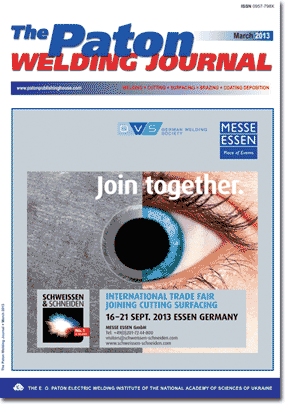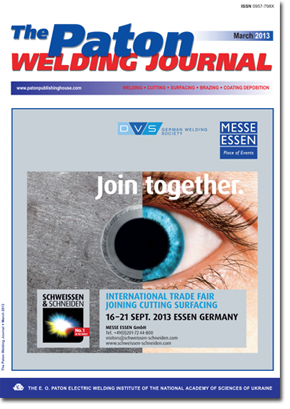| 2013 №03 (01) | 2013 №03 (03) |

The Paton Welding Journal, 2013, #3, 6-13 pages
MICROSTRUCTURE OF HAZ METAL OF JOINTS OF HIGH-STRENGTH STRUCTURAL STEEL WELDOX 1300
V.A. KOSTIN, G.M. GRIGORENKO, T.G. SOLOMIJCHUK, V.V. ZHUKOV and T.A. ZUBER
E.O. Paton Electric Welding Institute, NASU, Kiev, Ukraine
Abstract
Investigation of weldability of high-strength WELDOX 1300 steel with more than 1300 MPa yield limit is conducted under joint Ukrainian-Polish project, in order to assess the prospects for its application in crane construction in Ukraine. The objective of the work consisted in investigation of initial microstructure of WELDOX 1300 steel in as-delivered condition, influence of welding thermal cycle parameters on it, as well as plotting the thermokinetic diagram of austenite decomposition in this steel. This will allow optimization of arc welding modes to ensure high performance of the metal of weld and welded joint as a whole. The work was performed with application of procedures of light metallography, scanning microscopy, simulation of austenite transformation in Gleeble 3800 system, and computational methods of investigation. It was established that the microstructure of high-strength WELDOX 1300 steel in as-delivered condition consists of bainite-martensite mixture with a large number of finely-dispersed (50-100 nm) differently directed acicular precipitates of carbides of niobium NbC, titanium TiC, and iron Fe3C. A diagram of austenite transformation in this steel was plotted, and characteristic temperatures with new phase formation were determined. It is shown that preheating temperature should not be lower than 150 °C, in order to prevent cold cracking in welding WELDOX 1300 steel. Results of this work can be used in development of new welding technologies. 10 Ref., 4 Tables, 7 Figures.
Keywords: new steels, carbonitride strengthening, welding thermal cycle, Gleeble 3800, microstructure, bainite, martensite, acicular ferrite
Received: 25.12.12
Published: 28.03.13
References
1. Ozgovicz, W., Kurc, A., Nawrat, G. (2008) Identification of precipitations in anodically dissolved high-strength microalloyed Weldox steels. Archives of Materials Sci. and Eng., 31, 95-100.
2. Welding Hardox and Weldox. http://www. ssab.com
3. Ozgovicz, W., Kalinovska-Ozgowicz, E. (2008) Investigations on the impact strength of constructional high-strength Weldox steel at lowered temperature. Vol.32, 89-94.
4. (1974) Reference book of welder. Ed. by V.V. Stepanov. Moscow: Mashinostroenie.
5. Steven, W., Mayer, G. (1953) Continuous-cooling transformation diagrams of steels. Pt1. J. Iron and Steel Inst., 174, 33-45.
6. Zhdanov, S.L., Mikhoduj, L.I., Strizhak, P.A. et al. (1994) Structural transformations in welding of 17Kh2M steel and properties of welded joints. Avtomatich. Svarka, 9/10, 10-13.
7. Seferian, D. (1963) Welding metallurgy. Moscow: Metallurgizdat.
8. Gorbachev, I.I., Popov, V.V. (2009) Analysis of solubility of carbides, nitrides and carbonitrides in steels by computer-assisted methods of thermodynamics. Pt3: Solubility of carbides, nitrides and carbonitrides in Fe-Ti-C, Fe-Ti-N and Fe-Ti-C-N systems. Fizika Metallov i Metallovedenie, 108(5), 513-524.
9. Hrivnak, I. (1969) The study of the system Fe-V-C-N with a view to the precipitation hardening process. Czech. J. Physics, 19, 287.
10. Grabin, V.F., Denisenko, A.V. (1978) Metals science of low- and medium-alloy steels. Kiev: Naukova Dumka.
Suggested Citation
V.A. KOSTIN, G.M. GRIGORENKO, T.G. SOLOMIJCHUK, V.V. ZHUKOV and T.A. ZUBER (2013) MICROSTRUCTURE OF HAZ METAL OF JOINTS OF HIGH-STRENGTH STRUCTURAL STEEL WELDOX 1300. The Paton Welding J., 03, 6-13.The cost of subscription/purchase order journals or individual articles
| Journal/Currency | Annual Set | 1 issue printed |
1 issue |
one article |
| TPWJ/USD | 384 $ | 32 $ | 26 $ | 13 $ |
| TPWJ/EUR | 348 € | 29 € | 24 € | 12 € |
| TPWJ/UAH | 7200 UAH | 600 UAH | 600 UAH | 280 UAH |
| AS/UAH | 1800 UAH | 300 UAH | 300 UAH | 150 UAH |
| AS/USD | 192 $ | 32 $ | 26 $ | 13 $ |
| AS/EUR | 180 € | 30 € | 25 € | 12 € |
| SEM/UAH | 1200 UAH | 300 UAH | 300 UAH | 150 UAH |
| SEM/USD | 128 $ | 32 $ | 26 $ | 13 $ |
| SEM/EUR | 120 € | 30 € | 25 € | 12 € |
| TDNK/UAH | 1200 UAH | 300 UAH | 300 UAH | 150 UAH |
| TDNK/USD | 128 $ | 32 $ | 26 $ | 13 $ |
| TDNK/EUR | 120 € | 30 € | 25 € | 15 € |
AS = «Automatic Welding» - 6 issues per year;
TPWJ = «PATON WELDING JOURNAL» - 12 issues per year;
SEM = «Electrometallurgy Today» - 4 issues per year;
TDNK = «Technical Diagnostics and Non-Destructive Testing» - 4 issues per year.


